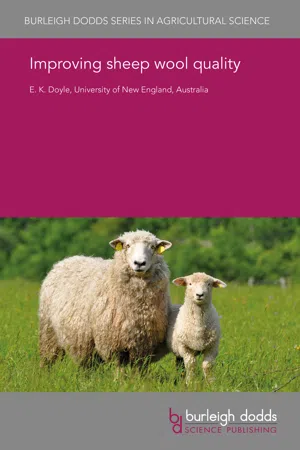Improving sheep wool quality
About this book
Wool is a natural fibre produced by nearly 500 different sheep breeds. Mean fibre diameter is the most important wool quality parameter and has the largest influence on the value of wool. Wool fibre competes with synthetic, cellulosic and cotton fibre consumption, and currently makes up 1.2% of world fibre production. This chapter considers five key areas where the wool industry needs to increase efficiency and improve the management of sheep in order to maintain market share and remain competitive. We review the utilisation of breeding values, health and welfare management for improved wool quality, optimisation of nutritional management, adoption of precision sheep management and improving consumer awareness of the provenance of wool products. The focus of the chapter is the quality of Merino wool.
Frequently asked questions
- Essential is ideal for learners and professionals who enjoy exploring a wide range of subjects. Access the Essential Library with 800,000+ trusted titles and best-sellers across business, personal growth, and the humanities. Includes unlimited reading time and Standard Read Aloud voice.
- Complete: Perfect for advanced learners and researchers needing full, unrestricted access. Unlock 1.4M+ books across hundreds of subjects, including academic and specialized titles. The Complete Plan also includes advanced features like Premium Read Aloud and Research Assistant.
Please note we cannot support devices running on iOS 13 and Android 7 or earlier. Learn more about using the app.
Information
Table of contents
- 1 Introduction
- 2 Wool quality
- 3 Wool production
- 4 Selection of superior genetics and breeding
- 5 Health and welfare management for improved wool quality
- 6 Nutritional management and wool production
- 7 Precision sheep management
- 8 Woollen products and consumer awareness of provenance
- 9 Conclusion: sustainability of the wool industry into the future
- 10 Where to look for further information
- 11 References
